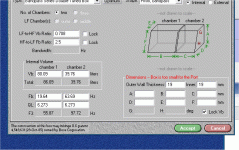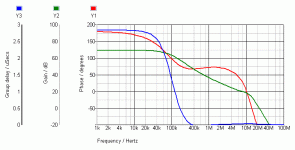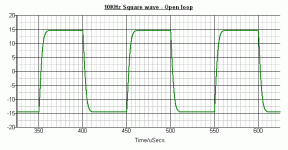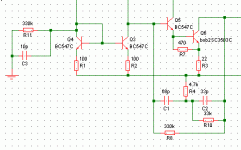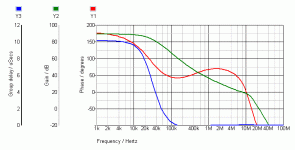As far as I can tell, the US patent office will grant anything.
Not true
I understand that the invention is not required to to be useful or to actually work...
Not true
apparently they don't even bother to check that the idea is new and not easily derived from prior art.
Not true
Your baby? Are you sure?
Hello E
You may have noticed that they ripped off TMC as apposed to TPC with a couple of extra parts (to get good step response).
Arthur
To all,
Please have a look at: US Patent 7652531
Those pirates have stolen my baby!
@ raven1985, thx for the info.
Cheers,
E.
Hi Edmond,
You're not alone; same thing with Halcro and HEC.
Cheers,
Bob
I reckon any ratio of capacitors can be made to work optimally well in both cases. I do not subscribe to the view that there is an "optimal ratio" of capacitors for TPC or TMC.
Hi Mike,
We may be dealing with semantical nitpicking here. I can only tell you that in my experience TMC does not work as well with C1=C2, and works very well with C2>>C1.
On the other hand, my experience with TPC works quite well with C1=C2.
To describe those experiences as having or advocating an optimum choise would be over doing it. However, I think each technique can be sub-par in its performance by making poor choice for the ratio. Moreover, what is a poor choive for one of the techniques may not be a poor choice for the other technique.
Cheers,
Bob
Hi Edmond,
You're not alone; same thing with Halcro and HEC.
Cheers,
Bob
As they say, copycatting is the sincerest form of flattery....
jan didden
To all,
Please have a look at: US Patent 7652531
Those pirates have stolen my baby!
@ raven1985, thx for the info.
Cheers,
E.
Poor fools, they spend upwards of $10,000 to have the privilege of spending upwards of $500,000 to defend the patent. I don't see a financial or business model that would justify the effort. If they came to me for a license I would either tell them to walk, or change the design to something different, whichever will yield the fewest phone calls.
Not to mention that the first claim may not hold up since there is a lot of prior art to work around. The patent office is way overworked and the staff is not the brightest of IP lawyers. They are paid by the "piece" so a difficult patent to review is going to get a less thorough review. The real test is in court where deep pockets are necessary to play.
If the concept was published before 2008 they have nothing.
Attempting to read it suggests that they applied without a lawyer (each claim is a run on sentence and almost impossible to read) and no lawyer is listed. That could make defense even harder since figuring out the claims is essential to the first phase of a lawsuit.
Last edited:
Not saying I agree with this 100% but I believe that there is some truth here:
"Guru's Lair: Patent Avoidance Library"
"Guru's Lair: Patent Avoidance Library"
Attempting to read it suggests that they applied without a lawyer (each claim is a run on sentence and almost impossible to read)
As I recall, claims have to be structured as a single sentence,
so perhaps they are not experienced in disguising that.
To all,
Please have a look at: US Patent 7652531
Those pirates have stolen my baby!
@ raven1985, thx for the info.
Cheers,
E.
Don't worry , it doesn't work (on that amp).. anyways. The second part of the shown patent does , artu has implemented a varient of it.
I'll do as "bassbox" does with the Bose patent (below) ... "addition of the second capacitor/resistor infringes on US patent # 7652531" ...
Attachments
Last edited:
Not saying I agree with this 100% but I believe that there is some truth here:
"Guru's Lair: Patent Avoidance Library"
I wrote the above before reading Don Lancaster's stuff but I agree with him completely. With one exception I have had experience with; Patents are the honey in the bear trap used to get money from VC's. However the nastiest and most selfish people on earth are nicer than a Venture Capitalist.
I wrote the above before reading Don Lancaster's stuff but I agree with him completely. With one exception I have had experience with; Patents are the honey in the bear trap used to get money from VC's. However the nastiest and most selfish people on earth are nicer than a Venture Capitalist.
Don Lancaster is a great guy and a real audio pioneer, and he has certainly never been shy about sharing his opinions. I would not necessarily go as far as him, but I think he is largely on the right track when it comes to patents. At minimum, the patent office is just as disappointing as any other government agency, maybe more so. What a shame. I have had direct experience with some of these people, and it has been extraordinarily frustrating.
Cheers,
Bob
My sympathy on the pain of finding a patent for TMC. Hopefully papers by Baxandall can pre-date it, or the earliest discussions here on the forum can.
In any case, the Gunderson scheme, dating from 1985, looks capable of nearly the same effect by copying the output stage AC voltage back to the VAS/TIS collector:
http://www.diyaudio.com/forums/solid-state/83222-gunderson-compensation-9.html#post966868
The discussion there seems to have gotten choked off (almost like TMC nearly was!) before the really interesting refinements could be tested. Since the floating cascode scheme provides extra voltage gain only (in the VAS/TIS stage), it falls down with a bipolar output stage with drooping Beta. But a Mosfet output stage, or a Mosfet SF driver for a bipolar output stage should take full advantage of the additional voltage gain. Possibly a faster Mosfet cascode element could improve the HF performance of the local loop as well, improving stability.
I plan to check this out on a Slone Optimos amplifier, since it is already configured for such a setup, with only a minor change to the compensation network needed.
----------------------------
Also, I hope that the next edition of Bob's book can cover this (Gunderson ...), and also the functioning of the split output current sensing feedback used by Edmond in his recent designs. (the output stage feedback for TMC taken from the two output stage emitters/sources with a resistor summing network. Above the Re resistors, instead of from the center point of the Re resistors. For optimum class AB bias, since this seems to be another scheme that reduces the crossover distortion by altering the feedback. Well, and also the rail currents feedthru if a balance Pot is provided.)
In any case, the Gunderson scheme, dating from 1985, looks capable of nearly the same effect by copying the output stage AC voltage back to the VAS/TIS collector:
http://www.diyaudio.com/forums/solid-state/83222-gunderson-compensation-9.html#post966868
The discussion there seems to have gotten choked off (almost like TMC nearly was!) before the really interesting refinements could be tested. Since the floating cascode scheme provides extra voltage gain only (in the VAS/TIS stage), it falls down with a bipolar output stage with drooping Beta. But a Mosfet output stage, or a Mosfet SF driver for a bipolar output stage should take full advantage of the additional voltage gain. Possibly a faster Mosfet cascode element could improve the HF performance of the local loop as well, improving stability.
I plan to check this out on a Slone Optimos amplifier, since it is already configured for such a setup, with only a minor change to the compensation network needed.
----------------------------
Also, I hope that the next edition of Bob's book can cover this (Gunderson ...), and also the functioning of the split output current sensing feedback used by Edmond in his recent designs. (the output stage feedback for TMC taken from the two output stage emitters/sources with a resistor summing network. Above the Re resistors, instead of from the center point of the Re resistors. For optimum class AB bias, since this seems to be another scheme that reduces the crossover distortion by altering the feedback. Well, and also the rail currents feedthru if a balance Pot is provided.)
Last edited:
My sympathy on the pain of finding a patent for TMC. Hopefully papers by Baxandall can pre-date it, or the earliest discussions here on the forum can.
In any case, the Gunderson scheme, dating from 1985, looks capable of nearly the same effect by copying the output stage AC voltage back to the VAS/TIS collector:
http://www.diyaudio.com/forums/solid-state/83222-gunderson-compensation-9.html#post966868
The discussion there seems to have gotten choked off (almost like TMC nearly was!) before the really interesting refinements could be tested. Since the floating cascode scheme provides extra voltage gain only (in the VAS/TIS stage), it falls down with a bipolar output stage with drooping Beta. But a Mosfet output stage, or a Mosfet SF driver for a bipolar output stage should take full advantage of the additional voltage gain. Possibly a faster Mosfet cascode element could improve the HF performance of the local loop as well, improving stability.
I plan to check this out on a Slone Optimos amplifier, since it is already configured for such a setup, with only a minor change to the compensation network needed.
----------------------------
Also, I hope that the next edition of Bob's book can cover this (Gunderson ...), and also the functioning of the split output current sensing feedback used by Edmond in his recent designs. (the output stage feedback for TMC taken from the two output stage emitters/sources with a resistor summing network. Above the Re resistors, instead of from the center point of the Re resistors. For optimum class AB bias, since this seems to be another scheme that reduces the crossover distortion by altering the feedback. Well, and also the rail currents feedthru if a balance Pot is provided.)
Hi smoking-amp,
I'll definitely look into the possibility of covering Gunderson in the second edition, and will certainly have more to say about TMC. Thanks for these suggestions.
Cheers,
Bob
A different approach with TPC/TMC
Hi all
Most of the discussion about TPC and TMC revolves around using these techniques to increase loop gain.
Another way of looking at it is that these techniques can be used to increase open-loop bandwidth for a given amount of loop gain.
E.g. for an amp with 30dB gain, if we want 40dB of global feedback with unity loop gain at 2MHz, we need 70dB open-loop gain and, while CMC would require a first order roll-off at 20KHz, with TPC we can use a second order roll-off at 100KHz instead. The first two pics below show the open-loop response of such an amp, and it's square wave output at 10KHz, open-loop, unfiltered.
With reasonably low open-loop distortion (say 0.1%), I would expect it to sound quite good as is, with no GNFB. With 40dB feedback, distortion drops to about 10PPM, which I think most would consider good enough. Importantly, distortion is reduced equally across the entire audio band.
In the schematic, R8 sets the low frequency gain, C1 and C2 set the unity loop gain frequency, R4 sets the 2'nd order breakpoint to about 500KHz, and R10 damps the 2'nd order roll-off at 100KHz (the same function as the extra capacitor in Bob's BTC scheme). R11 and C3 over on the left repair the damage to DC offset and PSRR caused by the compensation network.
~~~~~~~~~~~~~~~~~~~~~~~~~~~~~~~~~~~~~~~~
Ahem, to the eagle-eyed: Yes I only realised after doing all the sims and making all the pretty pictures that I goofed a bit with the values. As shown, the second order roll-off is from about 85 to 350KHz. To get 100 to 500 KHz, R4 should be decreased to 3K3 and R10 to 27K. It doesn't make much difference though. With the "correct" values, group delay drops to 2.5uS and the phase margin at 2MHz is about 3 or 4 degrees worse.
~~~~~~~~~~~~~~~~~~~~~~~~~~~~~~~~~~~~~~~~
Anyway, I'm sure many would want more than 40dB of global feedback, so as a second example, let's assume 60dB is required. While CMC would require a first order roll-off at 2KHz, with TPC we can use a second order roll-off at 30KHz instead - a definite improvement. To get the extra 20dB of loop gain, R8 should be increased ten-fold, and R10 about three-fold. The forth pic below shows the resulting open-loop response.
Cheers - Godfrey
Hi all
Most of the discussion about TPC and TMC revolves around using these techniques to increase loop gain.
Another way of looking at it is that these techniques can be used to increase open-loop bandwidth for a given amount of loop gain.
E.g. for an amp with 30dB gain, if we want 40dB of global feedback with unity loop gain at 2MHz, we need 70dB open-loop gain and, while CMC would require a first order roll-off at 20KHz, with TPC we can use a second order roll-off at 100KHz instead. The first two pics below show the open-loop response of such an amp, and it's square wave output at 10KHz, open-loop, unfiltered.
With reasonably low open-loop distortion (say 0.1%), I would expect it to sound quite good as is, with no GNFB. With 40dB feedback, distortion drops to about 10PPM, which I think most would consider good enough. Importantly, distortion is reduced equally across the entire audio band.
In the schematic, R8 sets the low frequency gain, C1 and C2 set the unity loop gain frequency, R4 sets the 2'nd order breakpoint to about 500KHz, and R10 damps the 2'nd order roll-off at 100KHz (the same function as the extra capacitor in Bob's BTC scheme). R11 and C3 over on the left repair the damage to DC offset and PSRR caused by the compensation network.
~~~~~~~~~~~~~~~~~~~~~~~~~~~~~~~~~~~~~~~~
Ahem, to the eagle-eyed: Yes I only realised after doing all the sims and making all the pretty pictures that I goofed a bit with the values. As shown, the second order roll-off is from about 85 to 350KHz. To get 100 to 500 KHz, R4 should be decreased to 3K3 and R10 to 27K. It doesn't make much difference though. With the "correct" values, group delay drops to 2.5uS and the phase margin at 2MHz is about 3 or 4 degrees worse.
~~~~~~~~~~~~~~~~~~~~~~~~~~~~~~~~~~~~~~~~
Anyway, I'm sure many would want more than 40dB of global feedback, so as a second example, let's assume 60dB is required. While CMC would require a first order roll-off at 2KHz, with TPC we can use a second order roll-off at 30KHz instead - a definite improvement. To get the extra 20dB of loop gain, R8 should be increased ten-fold, and R10 about three-fold. The forth pic below shows the resulting open-loop response.
Cheers - Godfrey
Attachments
Last edited:
To all,
Please have a look at: US Patent 7652531
Those pirates have stolen my baby!
@ raven1985, thx for the info.
Cheers,
E.
That's OK, their patent is worthless.
Let's examine just one statement (out of many questionable ones) made in Wang's patent:
"Class D power amplifier is also not suitable for high quality home audio products since it has to drive separate speaker systems which hardly have the required impedance characteristics."
If that's not a load of cr@p I don't know what is. I could read further and find plenty more cr@p. On top of that the guy can’t even write a grammatically correct sentence (and he had help).
The patent office is nothing but a bunch of moronic government employees. All you need to do is read a few patents in areas where you have some degree of knowledge and it will quickly become apparent that patents are usually reviewed by unqualified people.
The claim by the Wang that class D amps are not suitable for home audio systems because of the speaker impedance is preposterous. This patent was filed in 2008. If it were filed 10 years ago I might be able to understand, but as of 2008 it was clearly apparent that class D technology was suitable not only for home audio but professional audio as well. Get a clue Wang.
I have to assume patent examiner Steven Mottola never bothered to read anything about class D amps in the last 10 years, which makes him unqualified and incompetent to be a patent examiner IMHO. Not saying I could do better, but he’s certainly doing a lousy job, and we're paying this fool's salary.
That's OK, their patent is worthless.
Let's examine just one statement (out of many questionable ones) made in Wang's patent:
"Class D power amplifier is also not suitable for high quality home audio products since it has to drive separate speaker systems which hardly have the required impedance characteristics."
If that's not a load of cr@p I don't know what is. I could read further and find plenty more cr@p. On top of that the guy can’t even write a grammatically correct sentence (and he had help).
The patent office is nothing but a bunch of moronic government employees. All you need to do is read a few patents in areas where you have some degree of knowledge and it will quickly become apparent that patents are usually reviewed by unqualified people.
The claim by the Wang that class D amps are not suitable for home audio systems because of the speaker impedance is preposterous. This patent was filed in 2008. If it were filed 10 years ago I might be able to understand, but as of 2008 it was clearly apparent that class D technology was suitable not only for home audio but professional audio as well. Get a clue Wang.
I have to assume patent examiner Steven Mottola never bothered to read anything about class D amps in the last 10 years, which makes him unqualified and incompetent to be a patent examiner IMHO. Not saying I could do better, but he’s certainly doing a lousy job, and we're paying this fool's salary.
Patent examiners don't write the patents, dude. Next time you dump on someone behind an anonymous handle, know what you're talking about.
Patent examiners don't write the patents, dude. Next time you dump on someone behind an anonymous handle, know what you're talking about.
No, they don't write them but they do grant them. I believe that sampleaccurate's point was that there is no way this patent should have been granted.
Patent examiners don't write the patents, dude. Next time you dump on someone behind an anonymous handle, know what you're talking about.
Sure thing, dude. Do you want my name and home address? Am I supposed to post those, dude? Where's your name and address? If you post it your a fool.
No, they don't write them but they do grant them. I believe that sampleaccurate's point was that there is no way this patent should have been granted.
Prescisely. There are some excellent patent examiners to be sure, however, this particular guy isn't one of them.
If my words were too harsh I apologize, but I stand by my basic statements. My Dad was really scre#3d by the patent process. Amana (the oven people) basically walked all over his patent (disclaimer: IMHO) and there's not much he could do about it. He didn't have the money to fight it.
Last edited:
The patent office is nothing but a bunch of moronic government employees. All you need to do is read a few patents in areas where you have some degree of knowledge and it will quickly become apparent that patents are usually reviewed by unqualified people.
The claim by the Wang that class D amps are not suitable for home audio systems because of the speaker impedance is preposterous. This patent was filed in 2008. If it were filed 10 years ago I might be able to understand, but as of 2008 it was clearly apparent that class D technology was suitable not only for home audio but professional audio as well. Get a clue Wang.
I have to assume patent examiner Steven Mottola never bothered to read anything about class D amps in the last 10 years, which makes him unqualified and incompetent to be a patent examiner IMHO. Not saying I could do better, but he’s certainly doing a lousy job, and we're paying this fool's salary.
You are NOT paying his salary. It is a self-funded agency, funded by filing fees. In fact, congress sucks money away from this cash cow.
Like I said, examiners don't write the applications. The inventors and their attorneys do. Primary examiners are on production quotas of, say, 14 or so hours an application. That includes reading a cryptic application, interpreting claims, searching the prior art, writing an action, and in most cases, doing it again when there is a response from the applicant, and maybe reading an appeal and writing an answer. This is no matter how long the disclosure is, how many claims there are, or how big the stack of irrelevant prior art the applicant dumps on the examiner to make him have to review. If he doesn't keep up with production, he gets fired. So how much time do you think a "moronic" examiner is going to spend editing marketing puffery in disclosures in order to keep his job?
There is no guarantee of validity. Just how many internet forums do you think an examiner needs to search to be all knowing enough not to be labelled a moron??
An examiner's name goes on the patent even if he's maintained his rejection, but got overturned by the board of appeals. If a patent is invalid, it is no skin off your butt, either financially OR economically as a monopoly. So it is pretty petty to publically insult an examiner by name because your father's patent didn't give you a big inheritance.
- Home
- Amplifiers
- Solid State
- Bob Cordell Interview: Negative Feedback

